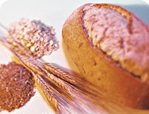
"Given the significant prevalence of refined grains, starches, and sugars in modern diets, identifying a unified criterion to identify higher quality carbohydrates is a key priority in public health," first author Rebecca Mozaffarian said.
Research has established that replacing refined grains with whole grains lowers the risk of obesity, cardiovascular disease and Type-II diabetes. This has led the U.S. Department of Agriculture (USDA) to recommend the consumption of at least three servings of whole grain foods per day. Similarly, the national school lunch program requires that half of all grain products be rich in whole grains. But in spite of these recommendations, there is no official definition for "whole grain" or "whole-grain rich."
In order to evaluate the definitions of whole-grain already in use, the researchers analyzed food products meeting one of five separate government or industry standards: foods containing at least eight grams of whole grains per serving (required to display the Whole-Grain Stamp, a project of the industry-funded Whole Grain Council); foods in which any whole grain is the first listed ingredient (a recommendation of the FDA and the USDA's MyPlate program); foods in which any whole grain is the first ingredient and without added sugars among the first three ingredients (also recommended by MyPlate); foods containing any ingredient in which the word "whole" appears before the name of a grain (recommended by the USDA's 2010 Dietary Guidelines); and foods with a total carbohydrate to fiber ration of fewer than ten to one (recommended by the American Heart Association, based on the ratio found in whole wheat flour).
The analysis was conducted on 545 separate grain products (bagels, breads, cereals, cereal bars, chips, crackers English muffins and granola bars) purchased from two major U.S. grocers.
10:1 ratio proves healthiest
Although the Whole Grain Stamp is one of the most widely used symbols on the front of food packages, the researchers found that foods bearing the stamp were actually higher in calories and sugar than products not bearing the stamp, although they were higher in fiber and lower in trans fats. They also found that the three standards recommended by the USDA did not consistently point to healthier food choices.
In contrast, foods that could be defined as whole grain under the ten to one ratio were higher in fiber and lower in sugar, sodium and trans fats that foods failing to meet the ratio. Foods meeting the ten to one ratio were no higher in calories than foods not meeting it.
"Our results will help inform national discussions about product labeling, school lunch programs, and guidance for consumers and organizations in their attempts to select whole grain products," senior author Steven Gortmaker said.





